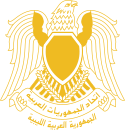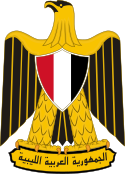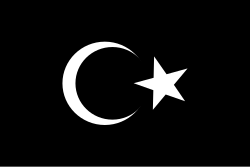Coat of arms of Libya (1952–1969)
The constitution of the Kingdom of Libya of 1952 in article 7 describes the flag, but not the emblem. No official description is available at present (due to the restrictions placed on government archives since the military coup of 1969), and the design is reconstructed from many variants in shape and color schemes. The 24dec1951.com website conducted research into the design as represented in official government sources of 1952-1969, and describes the emblem as follows:
- Top Crown adorned with a white Crescent and five-pointed star at its summit, at which five visible side frames originating from a ring at the base converge. The star studded base and frame contain a velvet black head cover like object.
- The Top Crown is supported at its base by two beautiful plantar designs; in the form of three intertwined C and S scroll shapes.
- Two massive “Shoulder” frames contain the body of the crown from the right and left [...]. Each side is a complex formation of intertwined branches in the shape of an S Curve, which is essentially two back-to-back C scrolls; the larger one of which terminates in a large beautiful spiral at the top. [...]
- The background color of the large interior below the Top Crown can be white or transparent, although this is not evident in the picture of the Libyan pound. The background color of the center region surrounding the large white Crescent and Star is black as in the center stripe of the Libyan flag.
- A white ring with thin black borders, surrounds the center large white Crescent and Star.
- Nine five-pointed white stars surround the center ring.
- Large white crescent.
- Five pointed star located well above the perimeter of the crescent. This differs from the flag, which places the star at the extremities of the crescent.
- A Center Crown, seated above the ring containing the Crescent and Star. Its design is identical to the Top Crown, except for being smaller in size.
- Plantar/ floral ornamentation similar to #2 above, providing variation and connectivity to the base.
- At the base, an elegant design that resembles a document scroll with a ring tie at its center. It is noted that the color scheme of the crown is most likely white for the stars and crescents, black and white (or transparent) for spaces, and gold for the crowns and frames. [...]
gif file from www.royalark.net/Libya, marked "Copyright© Christopher Buyers, December 2000 - October 2009", uploaded as File:Kingdom of Libya coat of arms.gif in 2009. A similar image was uploaded as
File:Coat of Arms of the Kingdom of Libya.jpg, taken from the now-defunct website libya4ever.com. See also File:Kingdom of Libya Passport.jpg and File:Libyan_Flag_Construction_Ministry_of_Information_and_Guidance_1951.jpg. The design was redrawn as vector graphics by Пакко in 2011.Relevantní obrázky
Relevantní články
Muhammad as-SenussiSaíd Muhammad ar-Rida bin Saíd Hasan ar-Rida al-Mahdí as-Senussi je syn libyjského korunního prince Hasana Senúsího a korunní princezny Fawzíy. Narodil se v Tripolisu a libyjskými royalisty je považován za legitimního následníka libyjského trůnu a za hlavu dynastie Senussi. Společně s ním si částečný nárok činí jeho vzdálený příbuzný Idris al-Senussi. .. pokračovat ve čtení
SenussiovéSenussi nebo Sanussi je název královské dynastie a muslimského politicko-náboženského hnutí v Libyi a regionu Súdán založené v Mekce roku 1837 Velkým Senussim, Saídem Muhammadem ibn Alí as-Senussi. Senussiové vládli Libyi oficiálně v letech 1951 až 1969, ale již od roku 1917 byli emíry Kyrenaiky. .. pokračovat ve čtení
Libyjské královstvíLibyjské království, v letech 1951–1963 oficiálním názvem Spojené království Libye, vzniklo po vyhlášení nezávislosti 24. prosince 1951 a trvalo až do 1. září 1969, kdy skupina armádních důstojníků v čele s Muammarem Kaddáfím po státním převratu svrhla krále Idrise I. a ustavili Libyjskou arabskou republiku. .. pokračovat ve čtení
Státní znak LibyeStátní znak Libye je po složitém politickém vývoji, občanské válce (2011), vojenské intervenci NATO a občanské válce dle různých zdrojů nejasný. .. pokračovat ve čtení
Linie následnictví libyjského trůnuNáslednictví libyjského trůnu se plně řídilo zásadou salického práva vzhledem k tomu že Libye patří k arabským a tudíž muslimským státům. Libyjské království bylo zrušeno v roce 1969, tudíž jsou současní následníci libyjského trůnu pretendenti. Současným pretendentem a hlavou rodu je Muhammad as-Senussi, který je druhým synem posledního libyjského korunního prince Hassana Senussiho, který byl synovcem krále Idrise I.. korunní princ Hassan se měl v roce 1969 stát králem po abdikaci krále Idrise, ale tuto událost o den předešla Kadaffím vedená vojenská revoluce. .. pokračovat ve čtení
Řád Idrise I.Řád Idrise I. byl řád Libyjského království založený roku 1947. Od pádu monarchie roku 1969 je udílen pouze jako dynastický řád. .. pokračovat ve čtení

















